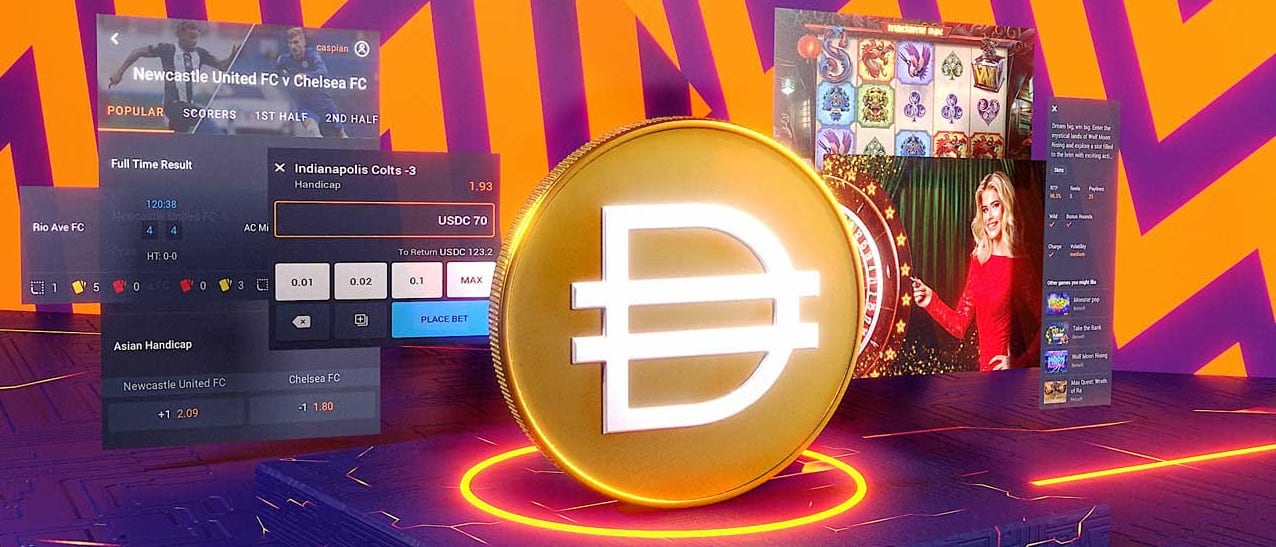Contents
Cloudbet adds DAI to its currency stable
Since its inception in 2013, a pioneering spirit has been, and remains, central to Cloudbet’s ethos and approach to delivering the best experience possible.
In its constant bid to advance through innovation, Cloudbet now adds DAI, the decentralised stablecoin from MakerDAO, to its stable of cryptocurrencies that players can buy and use, either in its leading bitcoin sportsbook or the Cloudbet bitcoin casino.
Cloudbet users can now choose between playing in Bitcoin (BTC), Ethereum (ETH), Bitcoin Cash (BCH), Paxos Gold (PAXG), USDT (Tether), USD Coin (USDC), and now DAI – making Cloudbet not only the leading bitcoin sportsbook and casino operator, but also the leading crypto sportsbook and casino operator.
What is DAI?
Stablecoins, generally pegged to the US dollar, emerged in response to the volatility of the crypto market and friction from moving in and out of the fiat world.
The DAI stablecoin has become one of the most widely adopted and utilised parts of decentralised finance and a key building block for the expansion of that movement.
However, this particular stablecoin differs from its counterparts. So, what exactly is DAI, how does it work, and how is it being used? To answer that, we need to look at the token itself, the DAO that governs it, the protocol, the vaults, decentralised finance and wider adoption.
Overview of DAI
In 2017, the first MakerDAO whitepaper was released, introducing the original DAI stablecoin system. MakerDAO is an open-source project and a Decentralised Autonomous Organisation.
DAI is a decentralised, collateral-backed cryptocurrency that is soft-pegged to the US dollar, its stability managed through a smart-contract system of borrowing and lending, built on Ethereum without the need for an intermediary. Essentially, DAI can be locked up to earn a savings yield; or approved collateral assets can be locked up to borrow DAI.
The whitepaper described how any user could generate DAI using this system by leveraging Ethereum (ETH) as collateral via Maker smart contracts, known as Collateralised Debt Positions (CDPs), which act as vaults for the collateral. Initially, as ETH was the only asset accepted as collateral for the system, DAI generated by it was a Single-Collateral DAI or ‘SAI.’
The DAI Stablecoin System became known as the Maker Protocol, based on the Ethereum blockchain, one of the larger decentralised applications (dApps) and the first decentralised finance (defi) application to generate significant adoption. It now accepts any Ethereum-based asset that has been approved by Maker (MKR) governance token holders, creating a Multi-Collateral DAI (MCD) system. MKR holders vote on the risk parameters for each of these assets, as a crucial component of Maker’s decentralised governance process.
The DAI stablecoin
Blockchain technology and decentralised finance provide us with the opportunity to escape the often dysfunctional way in which legacy centralised financial systems operate. The need and utility of stablecoins are long-established.
However, unlike DAI, fiat-collateralised options such as Tether (USDT), USD Coin (USDC), or the Paxos Standard (PAX), while having the benefit of inter-operating with the crypto ecosystem, still require 1:1 backing of USD and the need for a centralised authority. DAI, therefore, brings trustless and transparent stability to the crypto ecosystem.
DAI was one of the first to provide an alternative crypto-collateralised stablecoin that honours that decentralised vision. By moving away from the 1:1 USD model and the centralised and regulatory complications that entails, it provides a new means to generate and utilise a stablecoin still equal to one dollar and compatible with the wider ecosystem, but also decentralised in nature.
How is DAI created?
DAI is an ERC20 token generated by depositing approved collateral assets into smart contracts, called Maker Vaults, within the Maker Protocol. This process introduces DAI into circulation as a loan, providing liquidity that can be bought, sold and utilised just like any other cryptocurrency in the ecosystem.
Users can also optionally lock up the stablecoin in what is known as a DAI Savings Rate (DSR) contract in the Maker Protocol to earn savings automatically. The DSR also serves as one of the mechanisms for price stability whereby MKR holders can vote to modify the savings rate if the DAI price moves above or below the US$1 target.
Each DAI entering circulation is backed by excess collateral, rather than fiat dollars. It is, therefore, over-collateralised, meaning that the value of the assets locked remains higher than the DAI debt value, helping the system to account for volatility.
Its design ensures the supply of DAI cannot become altered by any participant. Instead, it is maintained via a system of smart contracts that dynamically respond to changes in the market price of collateralised assets.
MakerDAO
MakerDAO was established in 2014 as an open-source project, based on Ethereum, by CEO Rune Christensen. The Maker DAO project introduced the DAI Stablecoin System that has become the Maker Protocol, managed by a decentralised set of global participants holding its governance token, MKR.
The Maker Protocol is one of the most adopted dApps on the Ethereum blockchain, maintained by a decentralised group of developers, becoming a vital cog in the expanding defi ecosystem.
The protocol leverages approved assets as collateral via unique smart contracts known as Collateralised Debt Positions (CDPs) to generate DAI.
In addition to the smart contract infrastructure, the Maker Protocol also involves key groups to maintain operations: Keepers, Oracles, Global Settlers and MakerDAO teams.
Maker Protocol community
Keepers utilise protocol arbitrage opportunities to provide liquidity across the system, helping to maintain the US$1 target price by selling when it is above this and buying when below, participating in auctions when Maker Vaults are liquidated.
Oracles are decentralised external parties chosen by MKR voters to provide reliable real-time data on the prices of collateral assets in Maker Vaults.
Global Settlers are selected by MKR voters and act as the last line of defence against an attack on the governance process or oracle feeds, and to mitigate the risk of a large number of withdrawals in a short period.
Maker community individuals and organisations form DAO teams to perform specific services for MakerDAO.
Through a system of proposal polling and voting, holders govern the protocol and financial risks of DAI to ensure stability, transparency and efficiency. Every MKR token locked up in a voting contract equates to one governance vote.
Maker Vaults
Maker Vaults are smart contracts where the accepted collateral assets can be locked up to generate DAI. Each collateralised asset requires a separate vault. Users can access the Maker Protocol via various UIs to create and collateralise these vaults; MyEtherWallet, for example.
Generating DAI in this way creates an obligation to repay it, along with a stability fee to withdraw the collateral locked up in the vault again. The stability fee must get paid whenever a vault owner pays down the debt partially or fully to retrieve the collateral. It is an annual percentage yield on top of the existing vault debt, paid in DAI.
DAI stability
If the value of DAI falls below US$1, the stability fee will increase, making loans more expensive, reducing loan generation and therefore DAI’s supply – thus raising the price. If it exceeds US$1, the stability fee will reduce, making loans cheaper, increasing loans and DAI supply – thus lowering the price.
While predominantly stable throughout its existence, there have been periods where the system could not maintain the peg, before later reverting to the mean.
In 2019, a supply glut caused DAI to trade temporarily below US$1. MKR holders proceeded to vote on a series of stability fee hikes, increasing the borrowing rates until the peg became stabilised.
During the height of the 2020 defi bull run, the opposite was true, with DAI persistently pricing above US$1 for a few weeks. The stability fee was reduced, incentivising increased DAI supply, but the demand was still too strong. The stability fee was, therefore, raised by the Maker governance system instead, embracing the speculation and boosting revenues. This governance change allowed for an acceptance of being slightly above-peg for a brief period while benefiting the system and improving reserves for long-term stability.
There will therefore be periods of extremes where flexibility is necessary to temporarily remain above or below the peg, though that presents further arbitrage opportunities within the system too.
Automated auctions
As users are directly interacting with the protocol to create vaults, they are inherently non-custodial, so each user has complete control over the collateral, as long as it does not fall below the specified liquidation level for that position. If a vault reaches the point where it is too risky according to the parameters set by the Maker governance process for the asset, it will get liquidated.
Liquidation is handled through automated Maker Protocol Collateral Auctions after comparing the liquidation ratio to the current vault debt to collateral ratio to cover the vault’s outstanding obligations and help protect the wider system.
The Maker Buffer contains DAI proceeds from these collateral auctions, including liquidation fees, as well as the stability fees charged when collateral is retrieved. When this reaches a limit determined by the governance process, excess DAI is sold in a Surplus Auction and used to buy and anonymously destroy MKR from the total supply. The success of DAI incentivises good governance of the Maker Protocol by being intrinsically linked to the performance of MKR for its holders.
If a collateral auction does not raise enough DAI to cover vault obligations, it is converted to Protocol Debt and covered by DAI in the Maker Buffer. If there is not enough DAI in the Buffer, the protocol triggers a Debt Auction whereby MKR is minted and then sold to bidders for DAI. Again, this incentivises good governance as, if the system does not provide for a sufficient Buffer, MKR holders are then punished by an increase in its supply.
DAI – becoming the most popular asset in defi
Maker Protocol’s decentralised DAI stablecoin has quickly become the most used digital asset in the rapidly growing defi space. As participants can also use DAI to pay for gas in the Ethereum ecosystem, by creating defi dApps that accept DAI instead of ETH, developers can provide smoother onboarding and overall experience. Thanks to the composability of the Ethereum blockchain, they can also wrap DAI in different smart contracts, modified for various uses, including decentralised exchanges, asset management services, lending platforms, payment solutions and crypto-wallets.
DAI’s advantages have provided a high degree of confidence in the stablecoin and Maker Protocol for the defi community, contributing to the further growth and network effects of the Maker ecosystem. The utility of DAI, its increased rate of adoption, and the fact that Ethereum and the Maker Protocol allow developers to build new financial services on top of them provide endless opportunities for defi.
Over 400 projects have leveraged Maker’s network effects to date, tapping into the growing communities and pools of liquidity it has developed.
Liquidity is essential in building successful defi projects – without it you cannot encourage adoption and the project is likely to fail. Decentralised liquidity pools of tokens in smart contracts, shared across platforms, are vital to defi. This shared liquidity increases trading volume, attracting more users and scaling the project so it can add further services.
A core philosophy of defi – permissibility – can only be guaranteed when a platform can access an unbiased, stable unit of account like DAI. This fact has led to tremendous growth in its use across defi apps, which looks set to continue as further network effects and shared liquidity kick in.
Increasing adoption
The stable yet decentralised nature of DAI provides the opportunity for it to become increasingly adopted for working capital, hedging, collateralised loans, savings, cross-border transactions, e-commerce, digital art, gaming, prediction markets and more.
Interestingly, it has witnessed particular popularity in the Latin American market. Faced with struggling economies, hyperinflation, and capital controls, people throughout Latin America have begun turning to crypto as an alternative to failing domestic fiat currencies.
While cryptocurrencies are attractive, their volatility can be off-putting when compared to the safe haven of the US dollar. With such a clear need for a stable currency to protect people’s savings, which is also not subject to capital controls (unlike USD), DAI has emerged as an attractive store of value. Particularly so in Argentina, with trading volumes quadrupling in 2020 alone to over $20 million, and exchange and peer-to-peer platforms multiplying six-fold. This infrastructure and volume growth has allowed citizens to store their savings in DAI and convert back to their local currency as and when they need it, preserving as much value as possible, especially when combined with the DAI Savings Rate feature.
In the face of widespread currency devaluation, Latin America has embraced DAI, with mainstream adoption driven by real need and DAI providing an easy way to store value with a USD peg – a trend we may see repeated elsewhere in the years ahead.
Summary
The Maker Protocol allows users to generate DAI, a stable store of value that lives entirely on the Ethereum blockchain. DAI is a stablecoin that is not issued or administered by any centralised actor or trusted intermediary or counterparty. It provides stability in an otherwise volatile crypto market, the liquidity it requires, and the decentralised advantages and features for defi platforms and users that other stablecoins simply cannot provide. As a result, it is witnessing significant growth in adoption, both from the decentralised and traditional finance worlds.
Cloudbet’s Welcome Package
Open a Cloudbet account, make your first deposit, and take advantage of Cloudbet’s Welcome Package. New players can benefit from up to $2,500 in cash rewards, 10% rakeback on every bet, daily cash drops, and a unique Cash Vault reward that grows with your play.
Cloudbet is here to raise the game. It only takes a minute to raise yours.





